Anti-Inflammatory and Antioxidant Activity of Pollen Extract Collected by Scaptotrigona affinis postica: in silico, in vitro, and in vivo Studies
Abstract
1. Introduction
2. Materials and Methods
2.1. Pollen Collection and Extract Preparation
2.2. Determination of Total Phenolic Content (TPC)
2.3. Determinations of Total Flavonoid Concentration (TFC)
2.4. Determination of Antioxidant Activity
2.4.1. DPPH• Radical Scavenging Activity
2.4.2. Ferric Reducing Antioxidant Power Assay (FRAP)
2.4.3. ABTS•+ Assay
2.5. COX Inhibition Assay
2.6. Animals
2.7. Anti-Inflammatory Activity
2.7.1. Carrageenan-Induced Paw Edema Test
2.7.2. Dextran-Induced Paw Edema Test
2.8. Anti–Nociceptive Activity
2.8.1. Acetic Acid Writhing Test
2.8.2. Formalin Test
2.9. HPLC-ESI-MS/MS Analysis
2.10. Computational Study
2.10.1. Predictive Models and Theoretical Calculations
2.10.2. Molecular Docking
2.11. Statistical Analysis
3. Results
3.1. Total Phenolic Content, Total Flavonoids Content, and Antioxidant Activity
3.2. COX-1 and 2 Inhibition Assay
3.3. In Vivo Anti-Inflammatory Activity
3.3.1. Carrageenan-Induced Paw Edema Test
3.3.2. Dextran-Induced Paw Edema Test
3.4. In Vivo Anti-Nociceptive Activity
3.4.1. Acetic Acid Writhing Test
3.4.2. Formalin Test
3.5. LC-ESI-IT-MS/MS Analysis
3.6. Molecular Docking
4. Discussion
5. Conclusions
Author Contributions
Funding
Acknowledgments
Conflicts of Interest
References
- Imperatriz-Fonseca, V.L.; Nunes-Silva, P. As abelhas, os serviços ecossistêmicos e o Código Florestal Brasileiro. Biota Neotrop. 2010, 10, 59–62. [Google Scholar] [CrossRef][Green Version]
- Rao, P.V.; Krishnan, K.T.; Salleh, N.; Gan, S.H. Biological and therapeutic effects of honey produced by honey bees and stingless bees: A comparative review. Rev. Bras. Farmacogn. 2016, 26, 1–8. [Google Scholar] [CrossRef]
- Almeida-Muradian, L.B.; Pamplona, L.C.; Coimbra, S.; Barth, O.M. Chemical composition and botanical evaluation of dried bee pollen pellets. J. Food Compos. Anal. 2005, 18, 105–111. [Google Scholar] [CrossRef]
- Koval, V.M.; Tykhonov, O.I.; Shpychak, О.S. Study of specific pharmacological activity of standardized composition of bee product substances for treatment of urogenital system. Zaporozhye Med. J. 2017, 17, 642–646. [Google Scholar] [CrossRef]
- Denisow, B.; Denisow-Pietrzyk, M. Biological and therapeutic properties of bee pollen: A review. J. Sci. Food Agric. 2016, 96, 4303–4309. [Google Scholar] [CrossRef]
- Nogueira, P.N. Vida e Criação de Abelhas Indígenas Sem ferrão; Editora Parma: São Paulo, Brazil, 1997. [Google Scholar]
- Lopes, A.J.O.; Vasconcelos, C.C.; Pereira, F.A.N.; Silva, R.H.M.; dos Queiroz, P.F.S.; Fernandes, C.V.; Garcia, J.B.S.; Ramos, R.M.; da Rocha, C.Q.; de Lima, S.T.J.R.M.; et al. Anti-Inflammatory and antinociceptive activity of pollen extract collected by stingless bee Melipona fasciculata. Int. J. Mol. Sci. 2019, 20, 4512. [Google Scholar] [CrossRef]
- Batista, M.C.; Abreu, B.V.B.; Dutra, R.P.; Cunha, M.S.; Amaral, F.M.M.; Torres, L.M.B.; Ribeiro, M.N.S. Chemical composition and antioxidant activity of geopropolis produced by Melipona fasciculata (Meliponinae) in flooded fields and cerrado areas of Maranhão State, northeastern Brazil. Acta Amaz. 2016, 46, 315–322. [Google Scholar] [CrossRef]
- Ribeiro, M.H.M.; de Albuquerque, P.M.C.; da Luz, C.F.P. Pollen profile of Geopropolis samples collected of “Tiúba” (Melipona (Melikerria) fasciculata Smith 1854) in areas of Cerrado and flooded fields in the state of Maranhão, Brazil. Brazilian J. Bot. 2016, 39, 895–912. [Google Scholar] [CrossRef]
- Dutra, R.P.; Nogueira, A.M.C.; Marques, R.R.D.O.; Costa, M.C.P.; Ribeiro, M.N.S. Avaliação farmacognóstica de geoprópolis de Melipona fasciculata Smith da Baixada maranhense, Brasil. Brazilian J. Pharmacogn. 2008, 18, 557–562. [Google Scholar] [CrossRef]
- Dutra, R.P.; Barros Abreu, B.V.; Cunha, M.S.; Batista, M.C.A.; Torres, L.M.B.; Nascimento, F.R.F.; Ribeiro, M.N.S.; Guerra, R.N.M. Phenolic acids, hydrolyzable tannins, and antioxidant activity of geopropolis from the stingless bee Melipona fasciculata Smith. J. Agric. Food Chem. 2014, 62, 2549–2557. [Google Scholar] [CrossRef]
- Araújo, M.J.A.M.; Mattar, N.S.; Reis, A.S.; Serra, I.C.P.B.; Fialho, E.M.S.; Assunção, A.K.M.; Dutra, R.P.; Nogueira, A.M.C.; Libério, S.A.; Guerra, R.N.M.; et al. Pharmacognostic and acute toxicological evaluation of Scaptotrigona aff. postica propolis extract in pre-clinical assays. Nat. Prod. Res. 2011, 25, 1037–1046. [Google Scholar] [CrossRef]
- Araújo, M.J.A.M.; Dutra, R.P.; Costa, G.C.; Reis, A.S.; Assunção, A.K.M.; Libério, S.A.; Maciel, M.C.G.; Silva, L.A.; Guerra, R.N.M.; Ribeiro, M.N.S.; et al. Efeito do tratamento com própolis de Scaptotrigona aff. postica sobre o desenvolvimento do tumor de Ehrlich em camundongos. Rev. Bras. Farmacogn. 2010, 20, 580–587. [Google Scholar] [CrossRef][Green Version]
- Choi, E.-M. Antinociceptive and antiinflammatory activities of pine (Pinus densiflora) pollen extract. Phyther. Res. 2007, 21, 471–475. [Google Scholar] [CrossRef]
- Maruyama, H.; Sakamoto, T.; Araki, Y.; Hara, H. Anti-inflammatory effect of bee pollen ethanol extract from Cistus sp. of Spanish on carrageenan-induced rat hind paw edema. BMC Complement. Altern. Med. 2010, 10, 30. [Google Scholar] [CrossRef]
- Brand-Williams, W.; Cuvelier, M.E.; Berset, C. Use of a free radical method to evaluate antioxidant activity. LWT Food Sci. Technol. 1995, 28, 25–30. [Google Scholar] [CrossRef]
- Benzie, I.F.F.; Strain, J.J. The Ferric Reducing Ability of Plasma (FRAP) as a Measure of “Antioxidant Power”: The FRAP Assay. Anal. Biochem. 1996, 239, 70–76. [Google Scholar] [CrossRef] [PubMed]
- Re, R.; Pellegrini, N.; Proteggente, A.; Pannala, A.; Yang, M.; Rice-Evans, C. Antioxidant activity applying an improved ABTS radical cation decolorization assay. Free Radic. Biol. Med. 1999, 26, 1231–1237. [Google Scholar] [CrossRef]
- Chagas, V.T.; Sousa Coelho, R.M.R.; Gaspar, R.S.; da Silva, S.A.; Mastrogiovanni, M.; de Jesus Mendonça, C.; Ribeiro, M.N.S.; Andrade Paes, A.M.; Trostchansky, A. Corrigendum to Protective Effects of a Polyphenol-Rich Extract from Syzygium cumini (L.) Skeels Leaf on Oxidative Stress-Induced Diabetic Rats. Oxid. Med. Cell. Longev. 2019, 2019, 5785798. [Google Scholar] [CrossRef] [PubMed]
- Winter, C.A.; Risley, E.A.; Nuss, G.W. Carrageenin-Induced Edema in Hind Paw of the Rat as an Assay for Anti-inflammatory Drugs. Exp. Biol. Med. 1962, 111, 544–547. [Google Scholar] [CrossRef] [PubMed]
- Silva, R.H.M.; Lima, N.d.F.M.; Lopes, A.J.O.; Vasconcelos, C.C.; de Mesquita, J.W.C.; de Mesquita, L.S.S.; Lima, F.C.V.M.; Ribeiro, M.N.d.S.; Ramos, R.M.; Cartagenes, M.d.S.d.S.; et al. Antinociceptive Activity of Borreria verticillata: In vivo and In silico Studies. Front. Pharmacol. 2017, 8, 283. [Google Scholar] [CrossRef] [PubMed]
- Lo, T.N.; Almeida, A.P.; Beaven, M.A. Dextran and carrageenan evoke different inflammatory responses in rat with respect to composition of infiltrates and effect of indomethacin. J. Pharmacol. Exp. Ther. 1982, 221, 261–267. [Google Scholar] [PubMed]
- Koster, R.; Anderson, M.; Beer, E.J. Acetic acid for analgesic screening. Fed. Proc. 1959, 18, 412–416. [Google Scholar]
- Hunskaar, S.; Hole, K. The formalin test in mice: Dissociation between inflammatory and non-inflammatory pain. Pain 1987, 30, 103–114. [Google Scholar] [CrossRef]
- Frisch, M.J.; Trucks, G.W.; Schlegel, H.B.; Scuseria, G.E.; Robb, M.A.; Cheeseman, J.R.; Scalmani, G.; Barone, V.; Petersson, G.A.; Nakatsuji, H.; et al. Gaussian 09; Gaussian, Inc.: Wallingford, CT, USA, 2009. [Google Scholar]
- Dennington, R.; Keith, T.A.; Millam, J.M. GaussView5; Gaussian, Inc.: Wallingford, CT, USA, 2016. [Google Scholar]
- Goodsell, D.S.; Morris, G.M.; Olson, A.J. Automated docking of flexible ligands: Applications of AutoDock. J. Mol. Recognit. 1996, 9, 1–5. [Google Scholar] [CrossRef]
- Morris, G.M.; Huey, R.; Olson, A.J. Using AutoDock for ligand-receptor docking. Curr. Protoc. Bioinform. 2008, 24, 8.14.1–8.14.40. [Google Scholar] [CrossRef] [PubMed]
- Morris, G.M.; Huey, R.; Lindstrom, W.; Sanner, M.F.; Belew, R.K.; Goodsell, D.S.; Olson, A.J. AutoDock4 and AutoDockTools4: Automated docking with selective receptor flexibility. J. Comput. Chem. 2009, 30, 2785–2791. [Google Scholar] [CrossRef]
- Morris, G.M.; Goodsell, D.S.; Halliday, R.S.; Huey, R.; Hart, W.E.; Belew, R.K.; Olson, A.J. Automated docking using a Lamarckian genetic algorithm and an empirical binding free energy function. J. Comput. Chem. 1998, 19, 1639–1662. [Google Scholar] [CrossRef]
- Calado, G.P.; Lopes, A.J.O.; Costa Junior, L.M.; Lima, F.d.C.A.; Silva, L.A.; Pereira, W.S.; do Amaral, F.M.M.; Garcia, J.B.S.; Cartagenes, M.d.S.d.S.; Nascimento, F.R.F. Chenopodium ambrosioides L. Reduces Synovial Inflammation and Pain in Experimental Osteoarthritis. PLoS ONE 2015, 10, e0141886. [Google Scholar] [CrossRef]
- Araujo, M.J.A.M. Estudo de parâmetros toxicológicos em animais tratados com própolis e geoprópolis de abelhas nativas do Maranhão. Master’s Thesis, Universidade Federal do Maranhão, São Luís, MA, Brazil, 2009. (In Portuguese). [Google Scholar]
- Nogueira, A.M.C. Determinação de caracteres físico, químicos e físico- químicos de amostras de geoprópolis de Melipona fasciculata Smith (tiúba) e própolis de Scaptotrigona sp. (tubi) cultivadas em municípios do cerrado maranhense. Master’s Thesis, Universidade Federal do Maranhão, São Luís, MA, Brazil, 2008. (In Portuguese). [Google Scholar]
- Komosinska-Vassev, K.; Olczyk, P.; Kazmierczak, J.; Mencner, L.; Olczyk, K. Bee pollen: Chemical composition and therapeutic application. Evid. Based Complement. Altern. 2015, 2015, 1–6. [Google Scholar] [CrossRef]
- Carpes, S.T.; Mourão, G.B.; De Alencar, S.M.; Masson, M. Chemical composition and free radical scavenging activity of Apis mellifera bee pollen from Southern Brazil. Braz. J. Food Technol. 2009, 12, 220–229. [Google Scholar] [CrossRef]
- Villarreal, L.P.S. Composição Química E Atividade Antioxidante Do Pólen Coletado Pela Abelha Sem Ferrão: Melipona seminigra Cockerell, 1919. Master’s Thesis, Universidade Federal do Amazonas, Manaus, AM, Brazil, 2009. (In Portuguese). [Google Scholar]
- Morais, M.; Moreira, L.; Feas, X.; Estevinho, L.M. Honeybee-collected pollen from five Portuguese Natural Parks: Palynological origin, phenolic content, antioxidant properties and antimicrobial activity. Food Chem. Toxicol. 2011, 49, 1096–1101. [Google Scholar] [CrossRef] [PubMed]
- Akin, M.; Arabaci, G.; Saki, N. Total phenols, antioxidant potential and tyrosinase inhibitory activity of walnut (Juglans regia L.) leaf, husk and seed. Asian J. Chem. 2013, 25, 9337–9340. [Google Scholar] [CrossRef]
- de Florio Almeida, J.; dos Reis, A.S.; Heldt, L.F.S.; Pereira, D.; Bianchin, M.; de Moura, C.; Plata-Oviedo, M.V.; Haminiuk, C.W.I.; Ribeiro, I.S.; da Luz, C.F.P.; et al. Lyophilized bee pollen extract: A natural antioxidant source to prevent lipid oxidation in refrigerated sausages. LWT Food Sci. Technol. 2017, 76, 299–305. [Google Scholar] [CrossRef]
- Vasconcelos, M.R.S.; Duarte, A.W.F.; Gomes, E.P.; Silva, S.C.d.; Lopéz, A.M.Q. Physicochemical composition and antioxidant potential of bee pollen from different botanical sources in Alagoas, Brazil. Ciência e Agroctecnologia 2017, 41, 447–458. [Google Scholar] [CrossRef]
- Amancio, D.C.P. Compostos bioativos do pólen. Available online: https://estudogeral.sib.uc.pt/bitstream/10316/37852/1/Compostos%20bioativos%20do%20polen.pdf (accessed on 23 January 2020).
- Soares, S.E. Ácidos fenólicos como antioxidantes. Rev. Nutr. 2002, 15, 71–81. [Google Scholar] [CrossRef]
- Lee, J.-H. Intracellular Antioxidant Activity and Inhibition of Bee Pollens on the Production of Inflammatory Mediators (P06-081-19). Curr. Dev. Nutr. 2019, 3. [Google Scholar] [CrossRef]
- Vinegar, R.; Schreiber, W.; Hugo, R. Biphasic development of carrageenin edema in rats. J. Pharmacol. Exp. Ther. 1969, 166, 96–103. [Google Scholar]
- Vinegar, R.; Truax, J.F.; Selph, J.L.; Johnston, P.R.; Venable, A.L.; McKenzie, K.K. Pathway to carrageenan-induced inflammation in the hind limb of the rat. Fed. Proc. 1987, 46, 118–126. [Google Scholar]
- Alcalde Bahamonde, S.M.; Flores, M.L.; Córdoba, O.L.; Taira, C.A.; Gorzalczany, S. Antinociceptive and anti-inflammatory activities of an aqueous extract of Chiliotrichum diffusum. Rev. Bras. Farmacogn. 2013, 23, 699–705. [Google Scholar] [CrossRef]
- Radu, B.M.; Bramanti, P.; Osculati, F.; Flonta, M.-L.; Radu, M.; Bertini, G.; Fabene, P.F. Neurovascular Unit in Chronic Pain. Mediators Inflamm. 2013, 2013, 1–18. [Google Scholar] [CrossRef]
- Zielinska, D.; Wiczkowski, W.; Piskula, M.K. Determination of the Relative Contribution of Quercetin and Its Glucosides to the Antioxidant Capacity of Onion by Cyclic Voltammetry and Spectrophotometric Methods. J. Agric. Food Chem. 2008, 56, 3524–3531. [Google Scholar] [CrossRef] [PubMed]
- Huang, S.-T.; Chen, C.-T.; Chieng, K.-T.; Huang, S.-H.; Chiang, B.-H.; Wang, L.-F.; Kuo, H.-S.; Lin, C.-M. Inhibitory effects of a rice hull constituent on tumor necrosis factor alpha, prostaglandin E2, and cyclooxygenase-2 production in lipopolysaccharide-activated mouse macrophages. Ann. N. Y. Acad. Sci. 2005, 1042, 387–395. [Google Scholar] [CrossRef] [PubMed][Green Version]
- El-Shitany, N.A.; El-Bastawissy, E.A.; El-desoky, K. Ellagic acid protects against carrageenan-induced acute inflammation through inhibition of nuclear factor kappa B, inducible cyclooxygenase and proinflammatory cytokines and enhancement of interleukin-10 via an antioxidant mechanism. Int. Immunopharmacol. 2014, 19, 290–299. [Google Scholar] [CrossRef] [PubMed]
- Lv, H.; Yu, Z.; Zheng, Y.; Wang, L.; Qin, X.; Cheng, G.; Ci, X. Isovitexin Exerts Anti-Inflammatory and Anti-Oxidant Activities on Lipopolysaccharide-Induced Acute Lung Injury by Inhibiting MAPK and NF-kappaB and Activating HO-1/Nrf2 Pathways. Int. J. Biol. Sci. 2016, 12, 72–86. [Google Scholar] [CrossRef] [PubMed]
- De Melo, G.O.; Malvar, D.D.C.; Vanderlinde, F.A.; Rocha, F.F.; Pires, P.A.; Costa, E.A.; de Matos, L.G.; Kaiser, C.R.; Costa, S.S. Antinociceptive and anti-inflammatory kaempferol glycosides from Sedum dendroideum. J. Ethnopharmacol. 2009, 124, 228–232. [Google Scholar] [CrossRef]
- Vellosa, J.C.R.; Regasini, L.O.; Belló, C.; Schemberger, J.A.; Khalil, N.M.; de Araújo Morandim-Giannetti, A.; da Silva Bolzani, V.; Brunetti, I.L.; de Faria Oliveira, O.M.M. Preliminary in vitro and ex vivo evaluation of afzelin, kaempferitrin and pterogynoside action over free radicals and reactive oxygen species. Arch. Pharm. Res. 2015, 38, 1168–1177. [Google Scholar] [CrossRef]
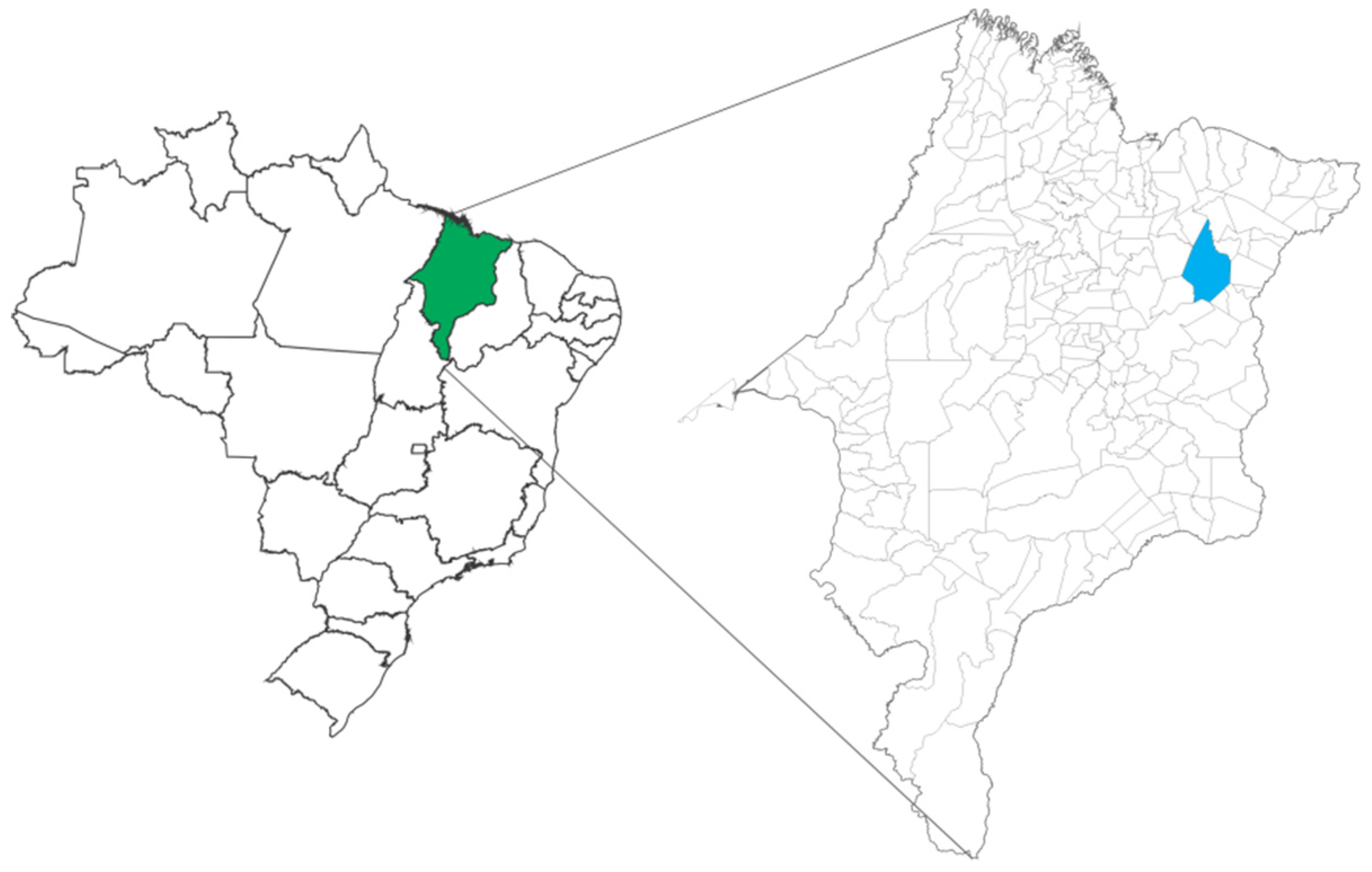
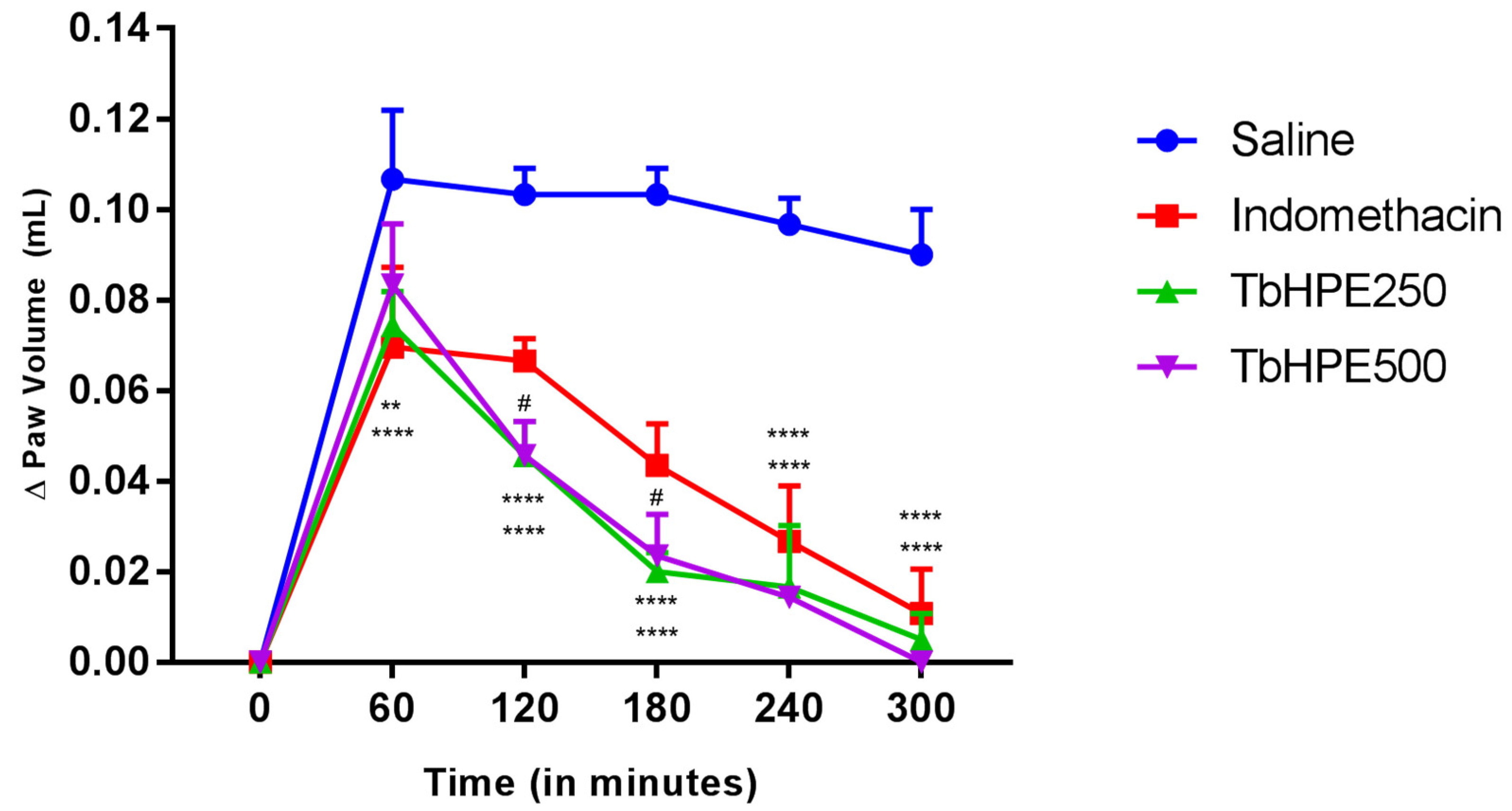
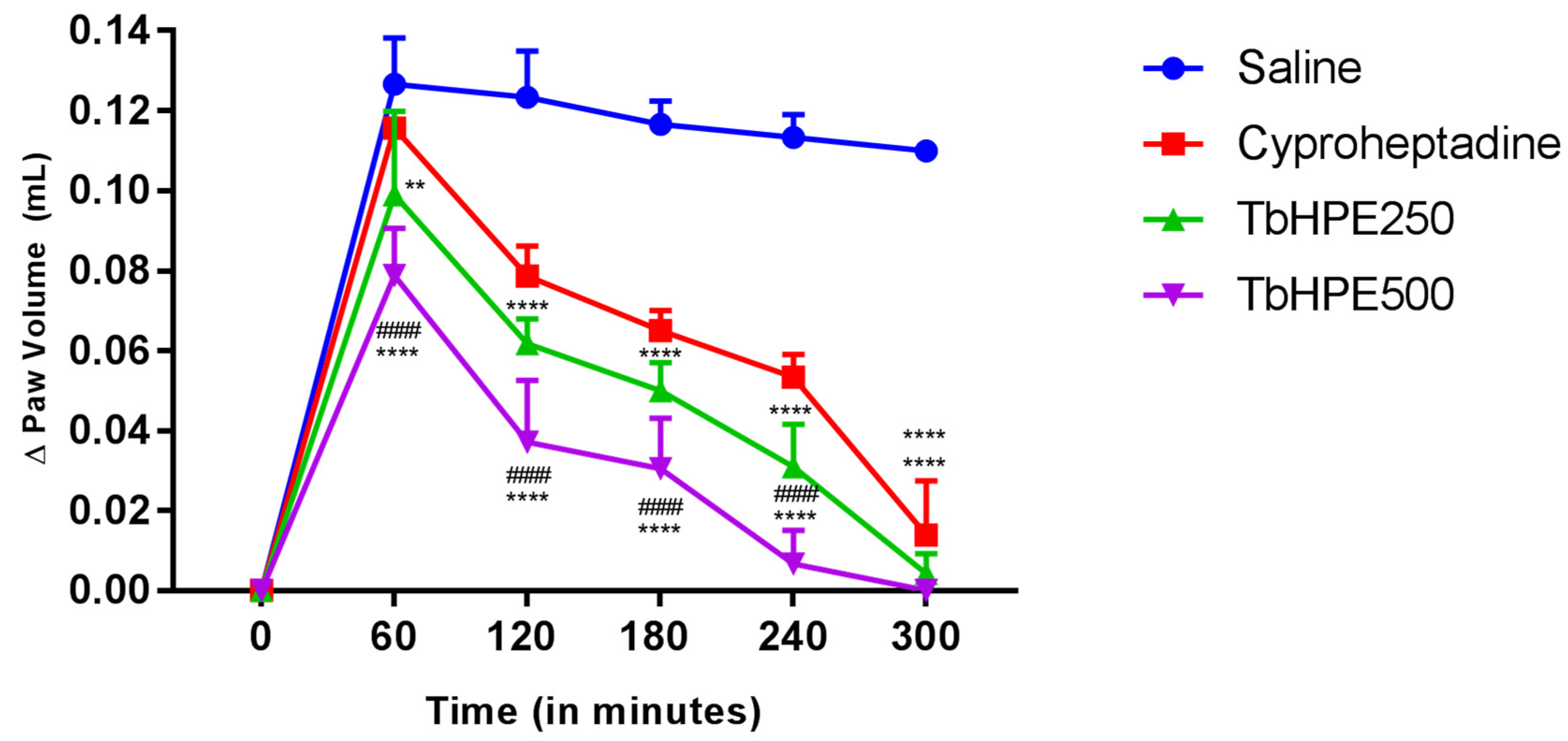
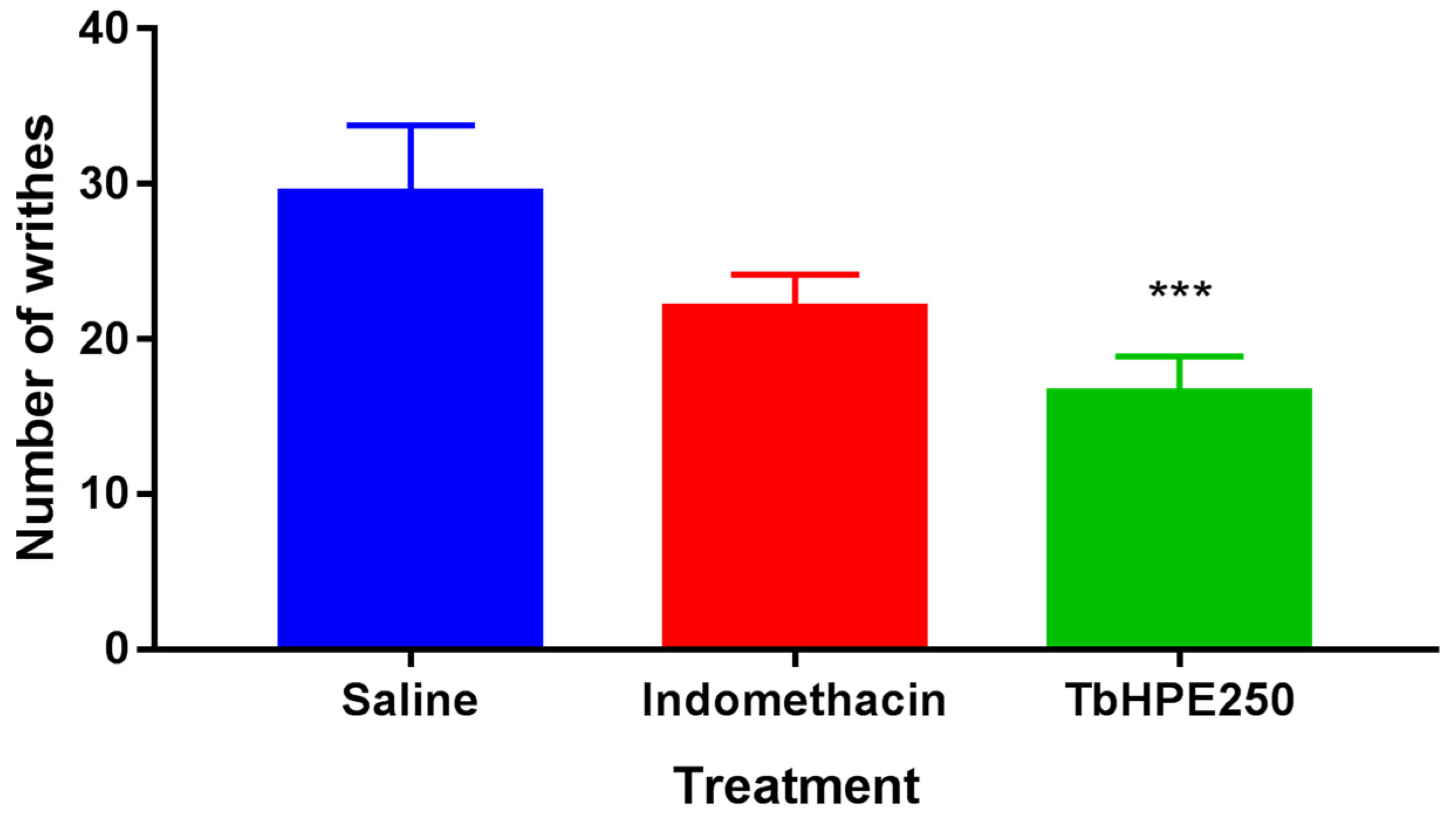
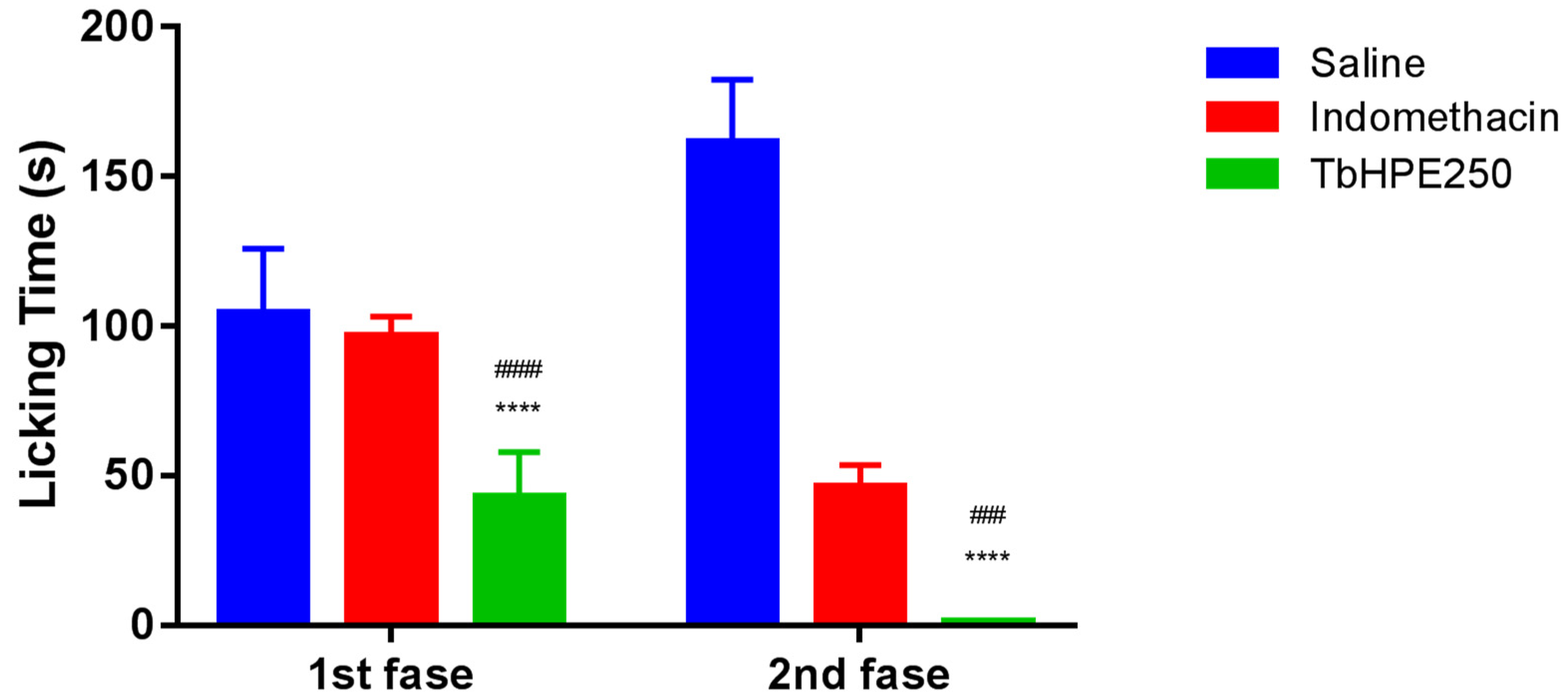
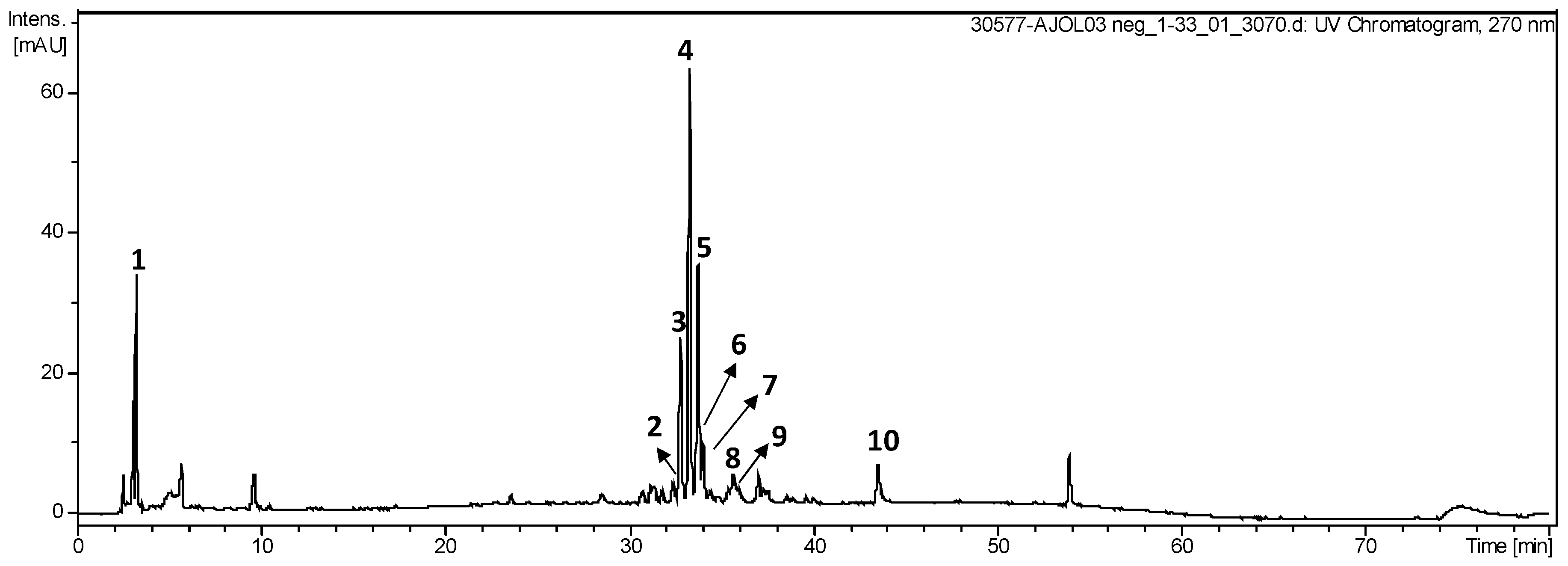
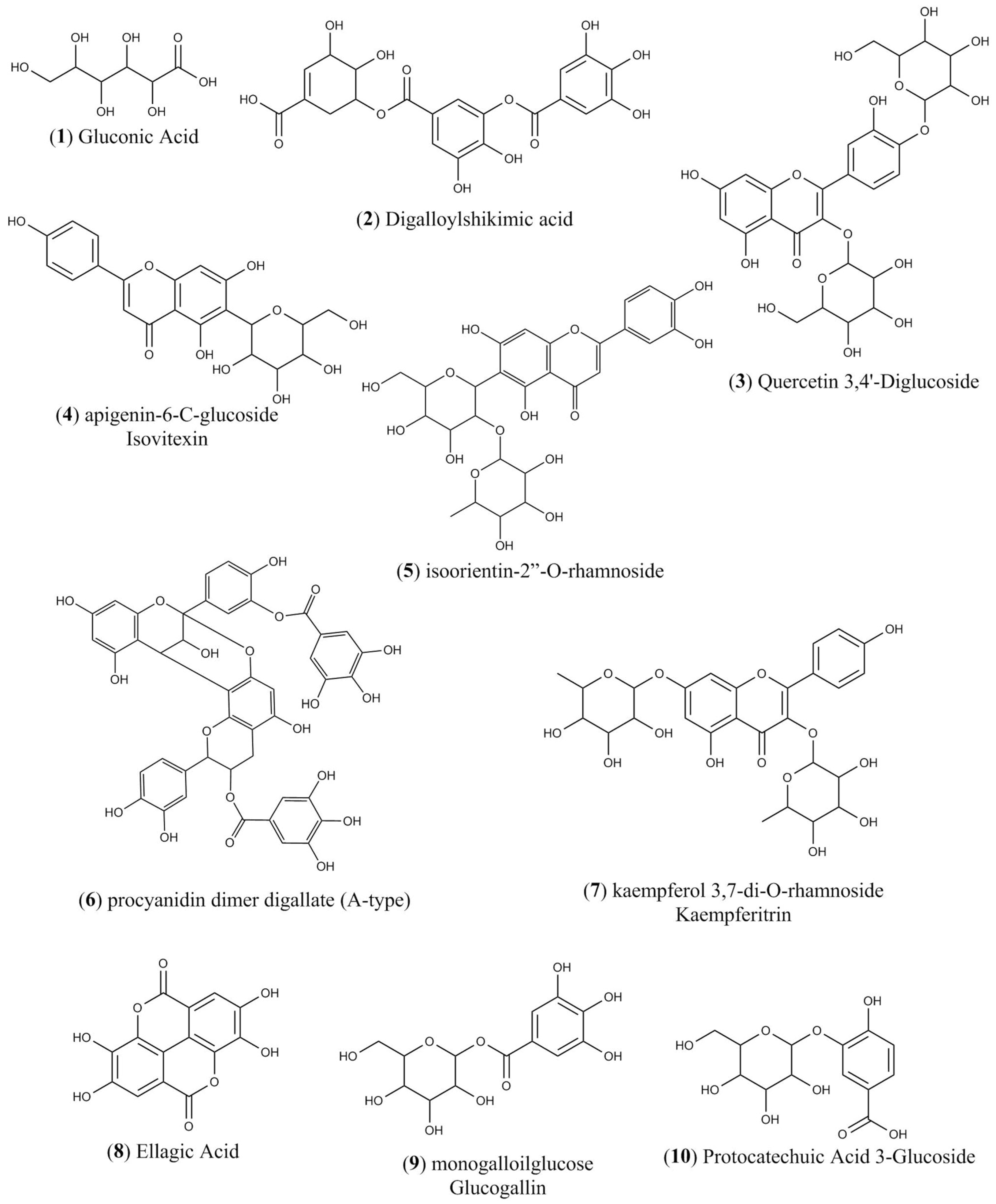

| Sample | TPC (%) * | TFC (%) ** | DPPH•IC50 (μg/mL) | FRAP (mmol Fe2+/g) | ABTS•+ IC50 (μg/mL) |
|---|---|---|---|---|---|
| TbHPE | 9.30 ± 0.56 | 0.40 ± 0.04 | 273.08 ± 1.43 b | 0.71 ± 0.04 b | 87.29 ± 0.06 b |
| Trolox | - | - | 3.08 ± 0.57 a | 8.87 ± 0.35 a | 3.67 ± 0.78 a |
| Isoform | % Inhibition | ||
|---|---|---|---|
| 2 µg/mL | 10 µg/mL | 50 µg/mL | |
| COX-1 | 22% | 42% | 86% |
| COX-2 | 0% | 29% | 91% |
| Nº | Retention Time (min) | [M−H]− | MSn Ion m/z (−) | Tentative Identification |
|---|---|---|---|---|
| 1 | 3.0 | 195 | 285; 177 | gluconic acid |
| 2 | 32.9 | 477 | 325; 315 | digalloylshikimic acid |
| 3 | 33.1 | 625 | 301 | quercetin-3,4-diglucoside |
| 4 | 33.4 | 431 | 311 | apigenin-6-C-glucoside |
| 5 | 33.6 | 593 | 429; 357 | isoorientin-2”-O-rhamnoside |
| 6 | 33.7 | 879 | 439; 289 | procyanidin dimmer digallate (a-type) |
| 7 | 33.8 | 577 | 285 | kaempferol 3,7-di-O-rhamnoside |
| 8 | 35.4 | 301 | - | ellagic acid |
| 9 | 35.3 | 331 | 315; 271; 209 | monogalloylglucose |
| 10 | 39.7 | 315 | 299; 153 | protocatechuic acid 3-glucoside |
| COX-2 | ||
|---|---|---|
| Ligand | ΔGbind (kcal/mol) | Ki (μM) |
| quercetin 3,4’-diglucoside | −8.09 | 1.15 |
| digalloylshikimic acid | −7.70 | 2.28 |
| ellagic acid | −7.63 | 2.65 |
| kaempferol 3,7-di-O-rhamnoside (kaempferitrin) | −7.59 | 2.75 |
| apigenin-6-C-glucoside (isovitexin) | −7.54 | 2.99 |
| isoorientin-2”-O-rhamnoside | −7.52 | 3.08 |
| monogalloylglucose | −7.15 | 5.74 |
| protocatechuic acid 3-glucoside | −6.85 | 8.65 |
| gluconic acid | −4.48 | 493.23 |
| indomethacin | −8.10 | 0.92 |
© 2020 by the authors. Licensee MDPI, Basel, Switzerland. This article is an open access article distributed under the terms and conditions of the Creative Commons Attribution (CC BY) license (http://creativecommons.org/licenses/by/4.0/).
Share and Cite
Lopes, A.J.O.; Vasconcelos, C.C.; Garcia, J.B.S.; Pinheiro, M.S.D.; Pereira, F.A.N.; Camelo, D.d.S.; Morais, S.V.d.; Freitas, J.R.B.; Rocha, C.Q.d.; Ribeiro, M.N.d.S.; et al. Anti-Inflammatory and Antioxidant Activity of Pollen Extract Collected by Scaptotrigona affinis postica: in silico, in vitro, and in vivo Studies. Antioxidants 2020, 9, 103. https://doi.org/10.3390/antiox9020103
Lopes AJO, Vasconcelos CC, Garcia JBS, Pinheiro MSD, Pereira FAN, Camelo DdS, Morais SVd, Freitas JRB, Rocha CQd, Ribeiro MNdS, et al. Anti-Inflammatory and Antioxidant Activity of Pollen Extract Collected by Scaptotrigona affinis postica: in silico, in vitro, and in vivo Studies. Antioxidants. 2020; 9(2):103. https://doi.org/10.3390/antiox9020103
Chicago/Turabian StyleLopes, Alberto Jorge Oliveira, Cleydlenne Costa Vasconcelos, João Batista Santos Garcia, Myssa Sued Dória Pinheiro, Francisco Assis Nascimento Pereira, Darleno de Sousa Camelo, Sebastião Vieira de Morais, José Roberto Brito Freitas, Cláudia Quintino da Rocha, Maria Nilce de Sousa Ribeiro, and et al. 2020. "Anti-Inflammatory and Antioxidant Activity of Pollen Extract Collected by Scaptotrigona affinis postica: in silico, in vitro, and in vivo Studies" Antioxidants 9, no. 2: 103. https://doi.org/10.3390/antiox9020103
APA StyleLopes, A. J. O., Vasconcelos, C. C., Garcia, J. B. S., Pinheiro, M. S. D., Pereira, F. A. N., Camelo, D. d. S., Morais, S. V. d., Freitas, J. R. B., Rocha, C. Q. d., Ribeiro, M. N. d. S., & Cartágenes, M. d. S. d. S. (2020). Anti-Inflammatory and Antioxidant Activity of Pollen Extract Collected by Scaptotrigona affinis postica: in silico, in vitro, and in vivo Studies. Antioxidants, 9(2), 103. https://doi.org/10.3390/antiox9020103







